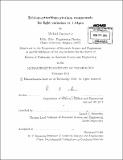Erbium-ytterbium-yttrium compounds for light emission at 1.54[mu]m
Author(s)
Vanhoutte, Michiel
DownloadFull printable version (15.61Mb)
Alternative title
Erbium compounds for light emission at 1.54[mu]m
Other Contributors
Massachusetts Institute of Technology. Department of Materials Science and Engineering.
Advisor
Lionel C. Kimerling.
Terms of use
Metadata
Show full item recordAbstract
Silicon microphotonics has emerged as the leading technology to overcome the interconnect bottleneck that limits a further increase of computation power following Moore's law. Optical interconnects between different electronic microprocessors in an electronic-photonic integrated circuit (EPIC) can provide a fast, low-loss and high-bandwidth alternative to electrical interconnects, which suffer from issues such as resistive heating, RC delays and channel crosstalk at an increasing device density. A crucial device in such an electronic-photonic integrated circuit is a compact, high-gain and low power optical amplifier to compensate for signal attenuation due to propagation losses and to recover signal strength after subsequent 3dB splits during fanout of the optical signal to different microprocessors. Erbium ions (Er3+) are an excellent candidate to provide amplification around [lambda] = 1.54[mu]m for optical telecommunications. Erbium-doped fiber amplifiers (EDFAs) have already enabled long-haul optical data transmission through silica optical fibers, but scaling down a fiber amplifier to an on-chip erbium-doped waveguide amplifier (EDWA) brings along significant materials and device design challenges. In this thesis, erbium-ytterbium oxide (Er.Yb2.0 3) and erbium-ytterbium-yttrium silicate (ErxYbYY 2 ,ySi 2O7 ) compounds are investigated as novel materials systems for the development of EDWAs. The high erbium and ytterbium solubility (>1022 cm-3) and refractive index (1.71 < n < 1.92) make these materials excellent candidates for compact, low-power optical amplifiers. ErxYb2.xo 3 and ErxYb2 -. Si2O7 thin films were deposited on Si0 2 and analyzed structurally and optically. The role of ytterbium in these compounds is twofold. First, ytterbium can be used as an alternative to yttrium for dilution of the erbium concentration in order to mitigate parasitic concentration quenching effects. Second, ytterbium acts as a sensitizer for erbium during optical pumping at [lambda] = 980nm. Comparison of the different oxide and silicate thin films reveals that the a-disilicate phase is the best candidate for an EDWA gain medium pumped at [lambda] = 980nm. By means of rate and propagation equations, the composition of an ErxYbY 2 -x-ySi 2 07 gain medium was optimized for application as a 3dB EDWA. The optimal composition was found to be Ero.02 5Ybo.2 00 Y1 .7 75 Si2 07, which provides a 1.5dB/cm gain at only 3mW of pump power. In terms of the figure of merit 3dB gain/(device area - pump power), this material outperforms other EDWA materials reported in literature.
Description
Thesis (Ph. D.)--Massachusetts Institute of Technology, Dept. of Materials Science and Engineering, 2013. In title on title page, "[mu]" appear as lower case Greek letter. Cataloged from PDF version of thesis. Includes bibliographical references (p. 181-193).
Date issued
2013Department
Massachusetts Institute of Technology. Department of Materials Science and EngineeringPublisher
Massachusetts Institute of Technology
Keywords
Materials Science and Engineering.